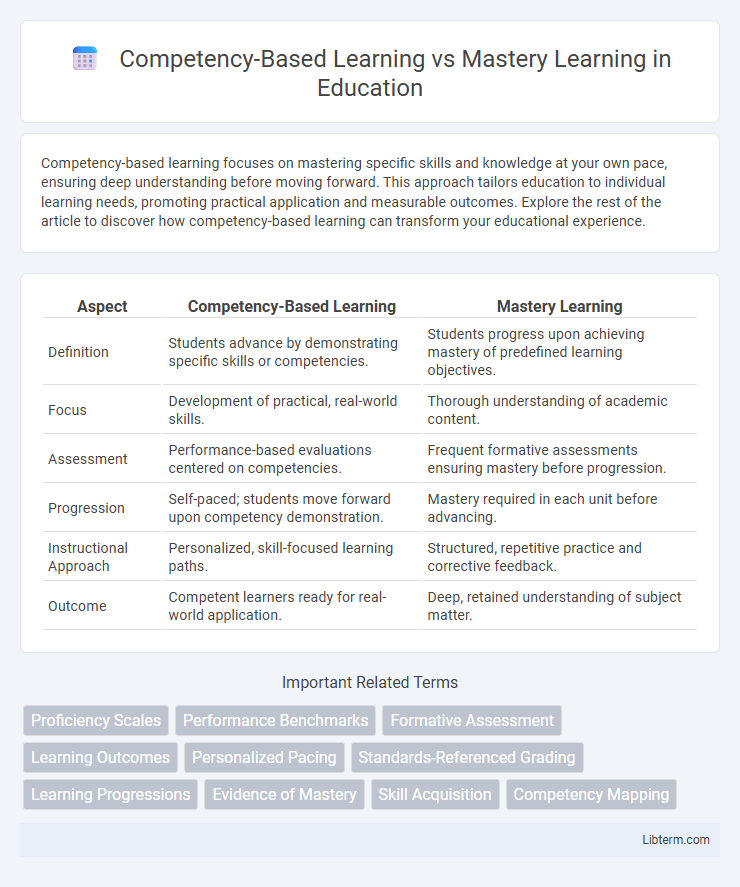Competency-based learning focuses on mastering specific skills and knowledge at your own pace, ensuring deep understanding before moving forward. This approach tailors education to individual learning needs, promoting practical application and measurable outcomes. Explore the rest of the article to discover how competency-based learning can transform your educational experience.
Table of Comparison
| Aspect | Competency-Based Learning | Mastery Learning |
|---|---|---|
| Definition | Students advance by demonstrating specific skills or competencies. | Students progress upon achieving mastery of predefined learning objectives. |
| Focus | Development of practical, real-world skills. | Thorough understanding of academic content. |
| Assessment | Performance-based evaluations centered on competencies. | Frequent formative assessments ensuring mastery before progression. |
| Progression | Self-paced; students move forward upon competency demonstration. | Mastery required in each unit before advancing. |
| Instructional Approach | Personalized, skill-focused learning paths. | Structured, repetitive practice and corrective feedback. |
| Outcome | Competent learners ready for real-world application. | Deep, retained understanding of subject matter. |
Introduction to Competency-Based and Mastery Learning
Competency-Based Learning emphasizes personalized progress through clearly defined skills and knowledge, ensuring students demonstrate proficiency before advancing. Mastery Learning requires students to achieve a high level of understanding in one topic before moving to the next, promoting retention and deep comprehension. Both models prioritize student-centered outcomes, but Competency-Based Learning allows more flexibility in pacing and assessment methods.
Defining Competency-Based Learning
Competency-Based Learning (CBL) emphasizes students acquiring specific skills and knowledge at their own pace, demonstrating mastery before progressing. This approach prioritizes measurable competencies rather than seat time or traditional grading systems, ensuring tailored learning paths aligned with real-world applications. CBL contrasts with Mastery Learning by focusing on broader skill sets and flexible pacing within defined competency frameworks.
Understanding Mastery Learning
Mastery Learning emphasizes achieving a deep, comprehensive understanding of specific skills or knowledge before progressing, ensuring learners reach a high proficiency level. It breaks content into manageable units and requires students to demonstrate mastery through assessments with targeted feedback and corrective instruction. This approach contrasts with Competency-Based Learning by focusing strictly on mastery thresholds rather than time or pace, promoting personalized learning paths to solidify concept retention.
Core Principles of Each Approach
Competency-Based Learning emphasizes the demonstration of specific skills and knowledge through clearly defined competencies, allowing learners to progress at their own pace once mastery is achieved. Mastery Learning centers on ensuring students achieve a high level of understanding in one topic before moving on to the next, employing formative assessments and corrective feedback to support mastery. Both approaches prioritize individualized learning, but Competency-Based Learning is skills-driven with flexible pacing, while Mastery Learning is content-driven with a sequential structure focused on mastery of each unit.
Differences in Curriculum Design
Competency-Based Learning structures curriculum around specific skills and outcomes that students must demonstrate proficiency in, allowing for flexible pacing and personalized progression. Mastery Learning emphasizes sequential understanding, requiring students to achieve a high level of mastery in one unit before advancing to the next, ensuring thorough comprehension. The core distinction lies in Competency-Based Learning's focus on real-world competencies and adaptability, whereas Mastery Learning prioritizes comprehensive mastery through uniform instructional phases.
Assessment Methods Compared
Competency-Based Learning (CBL) uses formative assessments that evaluate specific skills and knowledge aligned with clearly defined competencies, allowing students to progress upon demonstrating mastery. Mastery Learning employs frequent, criterion-referenced assessments to ensure students achieve a high level of understanding before moving forward, often incorporating corrective feedback and remediation. Both approaches emphasize mastery but differ in pacing and assessment timing, with CBL offering flexible progression and Mastery Learning relying on structured, repeated assessments.
Student Progression and Pacing
Competency-Based Learning (CBL) allows students to progress at their own pace by demonstrating specific skills and knowledge before moving forward, ensuring personalized learning trajectories. Mastery Learning requires students to achieve a high level of understanding in one topic before advancing to the next, often using formative assessments to confirm mastery. Both approaches prioritize student progression based on demonstrated learning outcomes rather than time spent, promoting deeper comprehension and skill acquisition.
Benefits and Challenges of Competency-Based Learning
Competency-based learning offers personalized education by allowing students to progress at their own pace upon demonstrating mastery of specific skills, which enhances learner engagement and retention. Benefits include flexibility, clear skill development, and alignment with real-world job requirements, making it ideal for workforce readiness. Challenges involve ensuring consistent assessment standards, potential resource intensiveness, and the need for faculty training to effectively implement and support individualized learning pathways.
Advantages and Limitations of Mastery Learning
Mastery Learning ensures students achieve a high level of understanding before progressing, which enhances retention and skill proficiency, leading to personalized pacing and reduced achievement gaps. Limitations include potential delays in curriculum completion, increased demand on instructional time, and challenges in maintaining motivation for students who struggle to master specific skills. This approach excels in structured environments but may require adaptive resources and continuous assessment to effectively support diverse learner needs.
Choosing the Right Model for Your Educational Setting
Choosing the right educational model hinges on understanding the distinctions between Competency-Based Learning (CBL) and Mastery Learning (ML). CBL emphasizes the acquisition of specific skills and behaviors, allowing flexibility in pacing, while ML requires students to achieve a high level of understanding in each unit before progressing, ensuring deep comprehension. Educational institutions must evaluate factors such as learner variability, curriculum design, and assessment methods to determine whether CBL's skill progression or ML's rigorous mastery aligns better with their instructional goals and student needs.
Competency-Based Learning Infographic

 libterm.com
libterm.com